
Yaojun Li, Mike Savage and Andrew Pickles (2003) 'Social Change,
Friendship and Civic Participation'
Sociological Research Online, vol. 8, no. 4,
<http://www.socresonline.org.uk/8/4/li.html>
To cite articles published in Sociological Research Online, please reference the above information and include paragraph numbers if necessary
Received: 25/11/2003 Accepted: 17/11/2003 Published: 28/11/2003
 Abstract
Abstract Introduction
Introduction Theoretical Issues
Theoretical Issues Data and Method
Data and MethodThe service class: professionals, administrators and managers;The petty bourgeoisie: self-employed workers with or without employees;
The intermediate class: routine-non-manual workers; foremen and manual supervisors; lower-grade technicians;
The working class: skilled, semi-skilled and unskilled workers.
 Class Formation and Friendship
Class Formation and Friendship| Table 1. The probability of having service-class friends by respondent's current class, parent's class, first-job class and mobility trajectories |
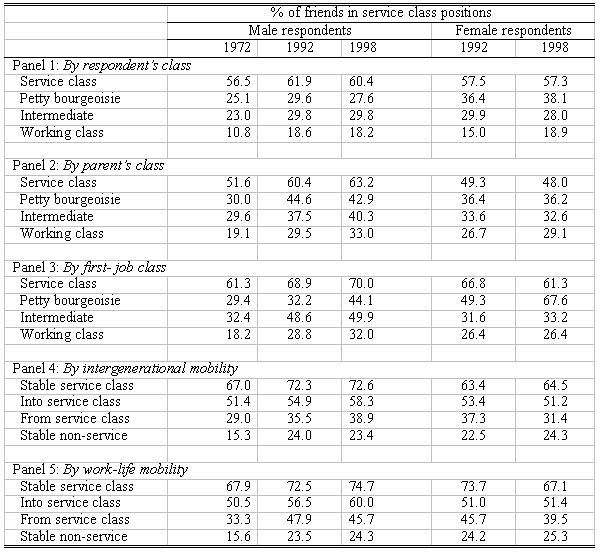
|
| Table 2 Logistic regression models of the effects of class, education and mobility on having service-class friends |
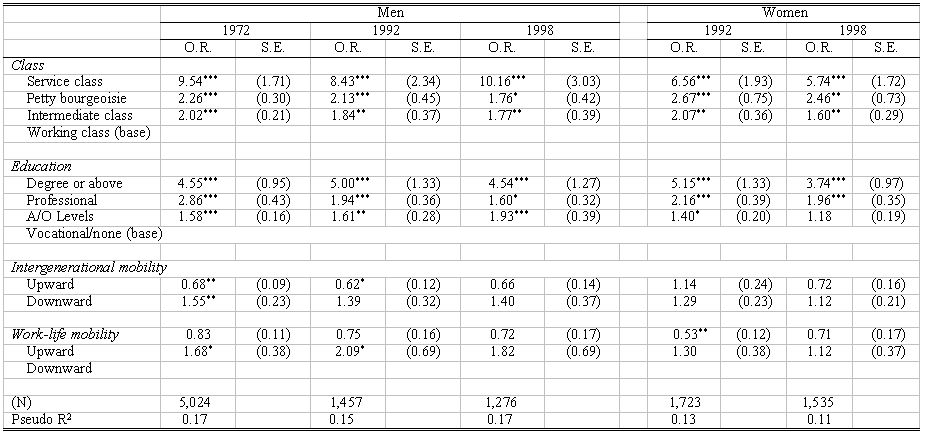
|
 Civic Engagement
Civic Engagement| Table 3 Participation (%) in civic associations in 1972 and 1992 |
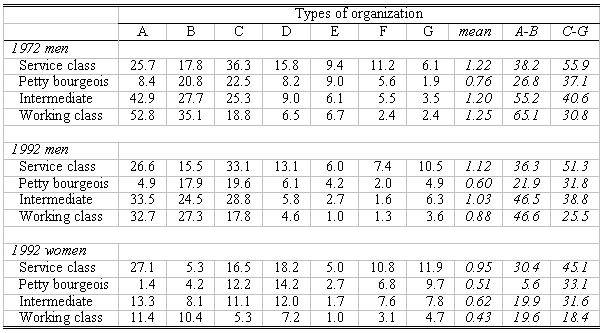
|
mean is the mean number of memberships in A-G;
A-B: Membership in trade union or working men's clubs ('working-class dominated'
organizations);
C-G: Membership in other organizations -- sports clubs, religious group, political party,
parent-teacher associations or tenants' groups ('service-class dominated' organizations).
| Table 4. Logistic regression models of the effects of class, education, mobility and friendship on memberships in working-class and service-class dominated organizations in 1972 and 1992, male respondents |
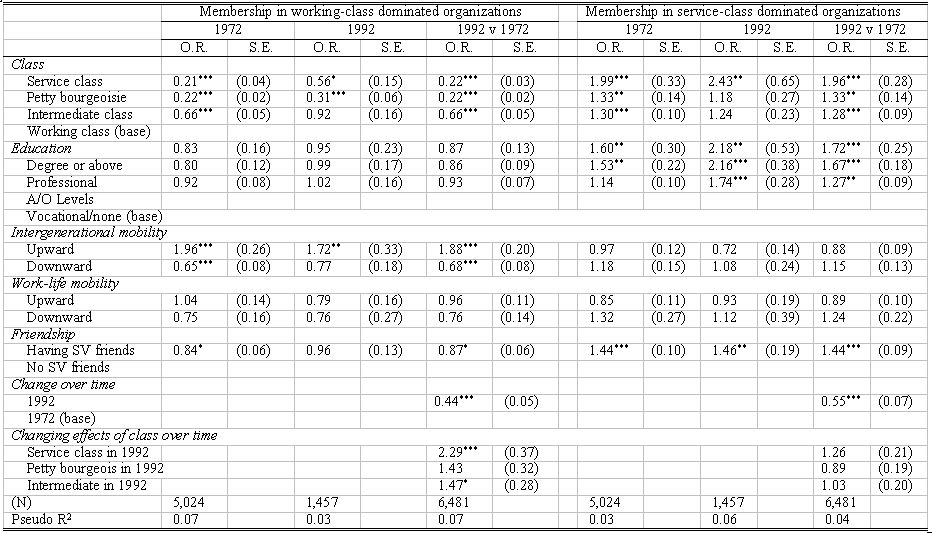
|
| Table 5 Logistic regression models of the effects of class, education, mobility and friendship on memberships in working- and service- class dominated organizations in 1992, female respondents |
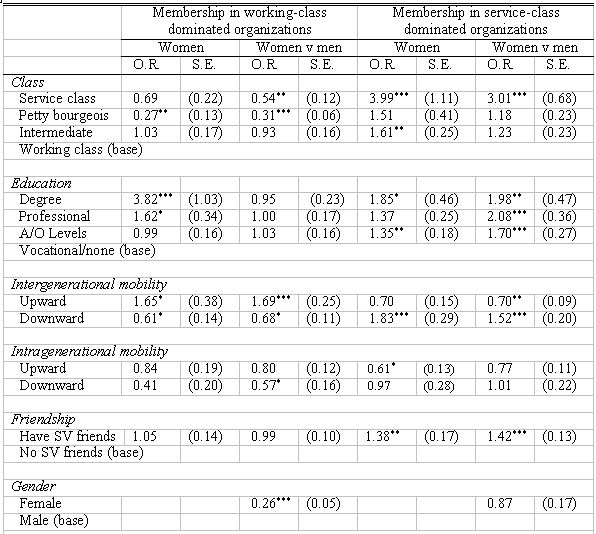 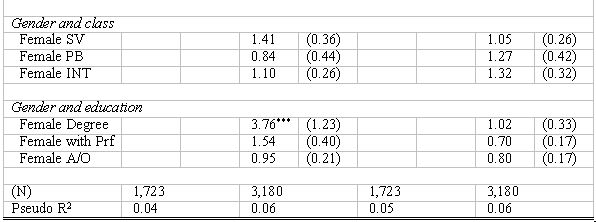
|
 Social Mobility,
Friendship Homogamy and Civic Engagement
Social Mobility,
Friendship Homogamy and Civic Engagement| Table 6 Social mobility, friendship homogamy, and participation in working- and service- class dominated organizations in 1972 and 1992, male respondents |

|
 Conclusion
Conclusion Notes
Notes2 For a critical evaluation of the thesis of declining social capital proposed by Putnam and the thesis of no decline proffered by Hall, see Li, Savage and Pickles (2003).
3 The BHPS data used in this paper were originally collected by the ESRC Research Centre on Micro-social Change at the University of Essex (now incorporated within the Institute for Social and Economic Research). Neither the original collectors of the data nor the Archive bear any responsibility for the analyses or interpretations presented here.
4 We are grateful to Professor Anthony Heath for suggestions over the algorithms used in constructing the educational variable in the SMI.
5 We could use 'parent class' and 'first-job class' as main-effects variables and then add interaction terms between respondent's current class and parent class, and between respondent's current class and first-job class. The results would be similar but the presentation much less straightforward.
6 We are interested in estimating the main and the 'mobility' effects of class. Long-range mobility is, following Goldthorpe (1987, p.43), defined as movement into or out of the service class. For this purpose, we have designed the class variables as follows (taking intergenerational mobility as an example):
| Respondent's class | ||||
| SV | PB | INT | WC | |
| Parent class | ||||
| SV | A | F | F | F |
| PB | E | B | C | D |
| INT | E | B | C | D |
| WC | E | B | C | D |
A: Intergenerationally stable service classGiven the way mobility is defined, respondents from INT or WC families and currently found in PB positions are combined with the intergenerationally stable petty bourgeois. Similarly, respondents from PB or WC families and currently situated in INT positions are classified as intergenerationally stable intermediate class, and those from PB or INT families and currently found in WC positions as intergenerationally stable working class. (The same is done for the first-job and current job categorisation.)
B: Intergenerationally stable petty bourgeoisie
C: Intergenerationally stable intermediate class
D: Intergenerationally stable working class
E: Intergenerationally upward mobile into the service class
F: Intergenerationally downward mobile from the service class
Strictly speaking, we ought to refer to classes as the inter-/intra- generationally stable service class, the inter-/intra-generationally stable petty bourgeoisie, and the inter-/intra-generationall stable working class each time we discuss the main class effects. However, for the ease of expression, we simply refer to them as the service class, the petty bourgeoisie and the intermediate class.
7 Further analysis shows, however, that there is no relative change in the propensity of the different classes in friendship construction. Holding constant all other variables in the model, the interaction model for 'time (1998 = 1, 1972 = 0) by class' has p values 0.44, 0.32 and 0.53 for the service-, petty bourgeois and intermediate classes and the F test results in chi2(3) = 1.13 and p = 0.77.
8 Holding constant all other variables in the model, the F test for the effect of the interaction terms for 'time*intergenerationally mobile into service class', 'time*intergenerationally mobile from service class' and 'time*worklife mobile from service class' results in chi2(3) = 0.28 and p = 0.96.
9 Further analysis, holding constant all other variables in the model, shows no relative change, between 1992 and 1998, in the propensity of different classes for women in friendship construction, the p values being 0.26, 0.72 and 0.21 respectively; nor any decline in the effects of educational qualifications, with p values being 0.26, 0.46 and 0.30 respectively.
10 As in the case of men, there was a very strong association between education and class. While only 8% of the women with the lowest educational qualifications were found in the service class in 1992 and 1998, nearly 80% of the degree holders were so found at both time points. Again similar to the case of men, there is no interaction effects between education and class once their main effects are controlled for.
11 Other scholars have made efforts in a similar direction. For instance, Hall says that 'the working class draws its organizational affiliations disproportionately from trade unions and workingmen's clubs' (1999, p.456).
12 The test for the service-class participation in 1992 and 1972 yields a chi-square value of 0.09 at one degree of freedom, at the 0.77 level. On the other hand, the test for the participation of the intermediate class has a chi-square value of 9.98 at one degree of freedom, at the 0.002 level.
13 A test for the interaction model for 'time (1992 = 1, 1972 = 0) by education' while controlling for all other variables in the model shows a significant change in the role of education in this regard. The odds ratios for degree, professional and A/O Levels were all around 1.5, and the p values for the latter two categories were significant at 0.05% and 0.01% levels.
14 The interaction term for the 'time and class' has p values of 0.17, 0.60 and 0.90 for service-, petty bourgeois-, and intermediate- classes respectively.
15 The F test for the 'female and class' and 'female and education' interaction model has chi2(6) = 38.72 and p = 0.00.
16 One main area for debate which we do not discuss here are Savage et al.'s (1992) arguments that Goldthorpe does not fully recognise the extent of intra-service class differentiation (see also Butler and Savage 1995; Li 1997, 2002). To address this issue it would be necessary to decompose the service class into professional and managerial wings which we will carry out in future analysis. Much can be gleaned on these issues in Li, 1997.
17 For the effects of social mobility, friendship construction and civic engagement on people's political preferences, see Savage and Li 2003. For the effects of social mobility on political preferences, see Clifford and Heath 1993; De Draaf, Nieuwbeerta and Heath 1995.
BLACKBURN, R.M. and PRANDY, K. (1997) 'The Reproduction of Social Inequality', Sociology, Vol. 31, pp. 491-507.
BOURDIEU, P. (1986) 'The Forms of Capital', in J. Westport (editor) Handbook of Theory and Research for the Sociology of Education. New York: Greenwood.
BOURDIEU, P. (1987) 'What Makes a Social Class? On the Theoretical and Practical Existence of Groups', Berkeley Journal of Sociology, Vol. 32, pp. 1-17.
BRITISH HOUSEHOLD PANEL SURVEY [computer file] (2001) Principal investigator, ESRC Research Centre on Micro-social Change. Colchester: The Data Archive [distributor]. Data files and associated documentation.
BUTLER, T. and SAVAGE, M. (editors) (1995) Social Change and the Middle Classes. London: UCL Press.
CLIFFORD, P. and HEATH, A. (1993) 'The Political Consequences of Social Mobility', Journal of the Royal Statistical Society,Series A (Statistics in Society) Vol. 156, pp. 51-61.
DE GRAAF, N., NIEUWBEERTA, P. and HEATH, A. (1995) 'Class Mobility and Political Preferences: Individual and Contextual Effects', American Journal of Sociology, Vol. 100, pp. 997-1027.
ERICKSON, B. H. (1996) 'Culture, Class, and Connections', American Journal of Sociology,Vol. 102, pp. 217-251.
ERIKSON, R. and GOLDTHORPE, J.H. (1992) The Constant Flux.Oxford: Clarendon Press.
FRANK, K. A., and YASUMOTO, J. Y. (1998) 'Linking Action to Social Structure Within a System: Social Capital Between and Within Subgroups', American Journal of Sociology,Vol. 104, pp. 642-686.
GIDDENS, A. (1971) Capitalism and Modern Social Theory.Cambridge: Cambridge University Press.
GOLDTHORPE, J.H. (1981/82) 'Social Standing, Class and Status', Social and Community Planning Research, Survey Methods Newsletter, pp. 8-11.
GOLDTHORPE, J.H (1982) 'On the Service Class, its Formation and Future', in A. Giddens and G. Mackenzie (editors) Social Class and the Division of Labour: Essays in Honour of Ilya Neustadt. Cambridge: Cambridge University Press.
GOLDTHORPE, J.H, with LLEWELLYN, C. and PAYNE, C. (1987) Social Mobility and Class Structure in Modern Britain.Oxford: Clarendon Press.
HALL,P. A. (1999) 'Social Capital in Britain', British Journal of Political Social Science,Vol. 29, pp. 417-461.
HEATH,A. F. (1981) Social Mobility.London: Fontana.
JAMIESON,L. (1998) Intimacy: Personal Relationships in Modern Societies.Cambridge: Polity.
LI, Y. (1997) The Service Class: Theoretical Debate and Sociological Value. D. Phil Thesis: Nuffield College, Oxford University.
LI, Y. (2002) 'Falling off the Ladder? Professional and Managerial Careers', European Sociological Review,Vol. 18, pp. 253- 270.
LI, Y., SAVAGE, M., TAMPUBOLON, G., WARDE, A. and TOMLINSON, M. (2002) 'Dynamics of Social Capital: Trends and Turnover in Associational Membership in England and Wales: 1972-1999', Sociological Research Online, Vol. 7, No. 3.
LI, Y., SAVAGE, M., and PICKLES, A. (2003) 'Social Capital and Social Exclusion in England and Wales (1972-1999)', Mimeo: University of Manchester.
LIN, N. (2001) Social Capital. Cambridge: Cambridge University Press.
MARSHALL, G., ROSE, D. NEWBY, H. and VOGLER, C. (1988) Social Class in Modern Britain. London: Hutchinson.
MARSHALL, G., SWIFT, A. and ROBERTS, R. (1997) Against the Odds? Social Class and Social Justice in Industrial Societies. Oxford: Clarendon Press.
MITCHELL, C.J. and CRITCHLEY, F. (1985) 'Configurational Similarity in Three Class Contexts in British Society', Sociology, Vol. 19, pp. 72-92.
PAHL,R. (2000) On Friendship. Cambridge: Polity.
PARKIN,F. (1971) Class Inequality and Political Order.London: McGibbon & Kee.
PAXTON,P. (1999) 'Is Social Capital Declining in the United States? A Multiple Indicator Assessment', American Journal of Sociology,Vol. 105, pp. 88-127.
PUTNAM,R. (1993) Making Democracy Work: Civic Traditions in Modern Italy. Princeton, N.J.: Princeton University Press.
PUTNAM, R. (1996) 'The Strange Disappearance of Civic America', American Prospect,Vol. 24, pp. 34-48.
PUTNAM, R. (2000) Bowling Alone: the Collapse and Revival of American Community.New York: Simon & Schuster.
SAVAGE, M. and LI, Y. (2003) 'Social Capital and Political Partisanship in England, 1972-1999', Mimeo, University of Manchester.
SAVAGE, M. (2000) Class Analysis and Social Transformation.Milton Keynes: Open University Press.
SAVAGE, M., BARLOW, J., DICKENS. P. and FIELDING, T. (1992) Property, Bureaucracy and Culture: Middle-class Formation in Contemporary Britain. London: Routledge.
STEWART, A., PRANDY, K. and BLACKBURN, R. (1980) Social Stratification and Occupations. London: Macmillan.
WARDE, A., TAMPUBOLON, G., TOMLINSON, M., RAY, K., LONGHURST, B. and SAVAGE, M (2001) 'Tendencies of Social Capital: Dynamics of Associational Membership', Paper delivered to the BSA Annual Conference, Manchester, April.
WRIGHT,E. O. (1978) Class, Crisis and the State.London: New Left Books.
WRIGHT, E. O. (1997) Class Counts. Cambridge: Cambridge University Press.